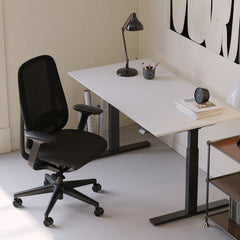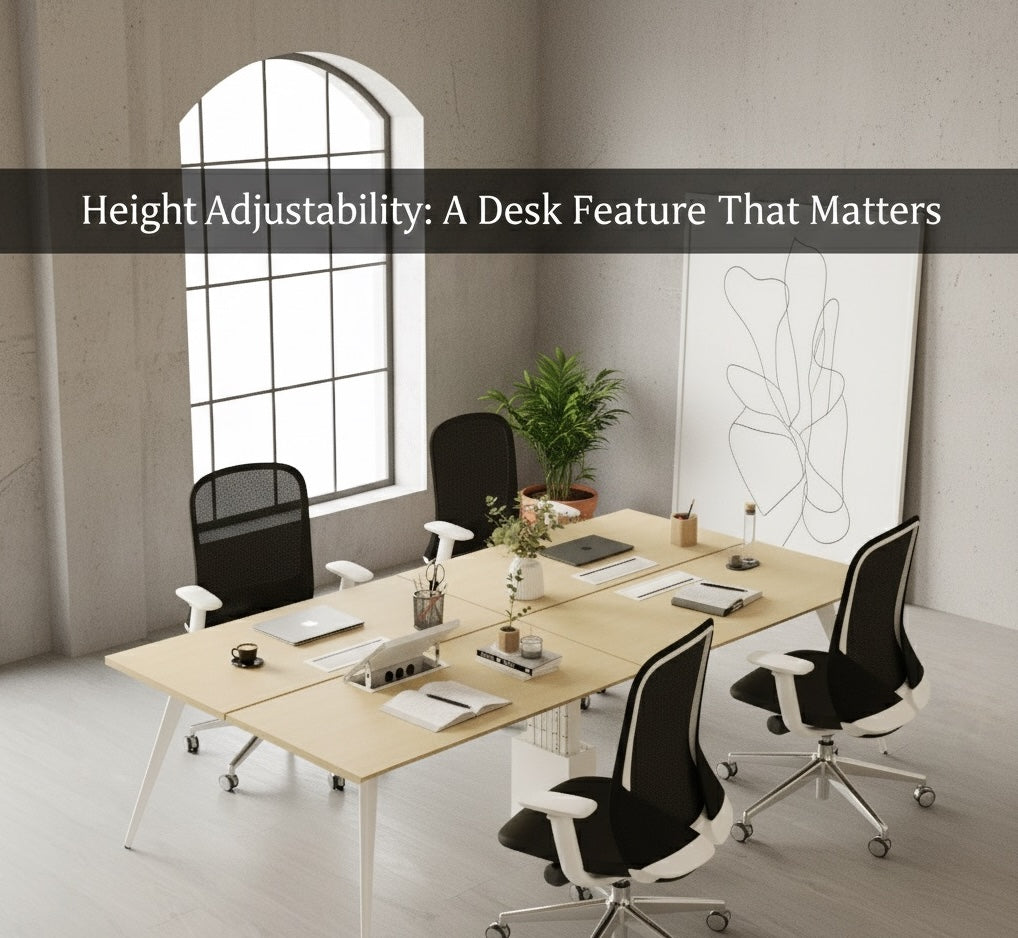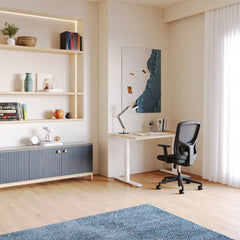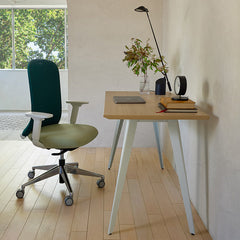Get 10% off your first order
Find the office furniture that’s designed to match your style, comfort, and needs perfectly. Subscribe
Blending Comfort, Quality, and Modern Style

Visit quiz page to see how we makes it easy to create an inspiring workplace


Fixed desks were built for a world of static tasks. Contemporary work alternates between research, writing, calls, design, and collaboration, often within the same hour. That rhythm rewards postural change. Height adjustability makes movement possible without breaking focus, letting people switch positions while maintaining proper alignment, reach, and sightlines.
The health rationale is straightforward. Prolonged sedentary time is associated with discomfort and musculoskeletal strain. Guidance from occupational health research, including NIOSH ergonomics guidance, explains how well-designed workstations help control risk factors through posture, reach, and task fit. A desk that adapts to each user enables neutral joint angles and regular micro-movements, two fundamentals that drive comfort throughout the day.
Neutral posture puts the spine in a natural S-curve, shoulders relaxed, elbows near the body, wrists in line, and neck balanced. Reach should keep frequently used tools within the primary zone so the upper arms remain close to the torso. Visual angles matter as much as arm angles. A top-of-monitor line near eye level helps reduce neck flexion, and arm supports at desk height keep wrists straight during typing or precision pointing.
Dynamic range describes how far a desk can travel while staying stable. A useful range covers seated postures for shorter users and full standing for taller users, without crowding monitors or creating wobble. Stability is not only a feel issue. When a surface shakes, users tense muscles to compensate, which slowly undermines comfort. A solid frame and dependable lift columns maintain alignment, even when the worksurface carries multiple monitors and peripherals.
Micro-movements are the small shifts that occur during a task. Adjustability lets those changes be intentional. Slightly higher for a drawing task, slightly lower for data entry, a gentle standing period for calls, and a seated position with arm support for long reading. These brief transitions reduce static load on the same tissues, which is central to long-term comfort.
Both manual crank and electric motor systems can serve the goal of posture variation. The right choice depends on frequency of transitions, the number of users, and acoustic expectations in the space.
| Feature | Manual Crank Lift | Electric Motor Lift |
|---|---|---|
| User Effort | Requires consistent turning, suitable for infrequent changes | Button control, better for frequent transitions |
| Transition Speed | Steady but slower | Quick and smooth, supports micro-adjustments |
| Acoustic Profile | Very quiet under load | Low sound if well engineered, important in open plans |
| Maintenance Profile | Minimal moving parts to service | Occasional motor or controller attention |
| Best Fit | Budget minded solo setups, light duty | Multiuser or team zones with frequent adjustments |
Lift columns act like the skeleton of the desk. Wider tube geometry, precise glides, and tight tolerances limit lateral movement at standing height. Frames should distribute weight across feet that contact the floor evenly. Anti-collision features help protect equipment and reduce risk when objects sit beneath or above the surface. These are practical safeguards in dynamic offices with shared gear.
Responsible sourcing and recyclability are meaningful in modern furniture programs. Powder-coated steel, engineered wood with thoughtful core materials, and replaceable components extend life and reduce waste. Longevity is a sustainability metric in itself since durable products avoid premature replacement.
Switching positions at natural breakpoints supports attention. Reading while seated, ideating while standing, and calling while slightly elevated are patterns that users report as helpful. Variation recruits different muscle groups and mitigates local fatigue, so mental resources can stay with the task rather than background discomfort.
Certain tasks favor specific setups. Precision text work often benefits from supported forearms and a lower keying height. Whiteboard collaboration pairs well with a higher desk that acts like a shared surface. Creatives who sketch or review proofs can tilt a monitor slightly and raise the deck to bring materials closer to eye line. Height control becomes a quiet assistant that fits the task rather than forcing the task to fit the furniture.
Pair stations and team benches can give each user their own preferred height in the same footprint. A shared layout with independent control supports inclusion and comfort without isolating teammates. Solutions such as dual user sit stand workstation demonstrate how adjacent positions can be individualized while collaborators remain side by side.
Tight floorplans can still deliver ergonomic variety. A compact adjustable platform keeps monitors, keyboard, and accessories in alignment while allowing full vertical travel. The compact sit stand workstation shows how careful engineering brings true adjustability to home studios and privacy rooms where every centimeter counts.
Corner placement can free aisle space. Centered cable routes prevent snags during travel. Light-colored tops maintain a sense of openness in small rooms. Accessories such as under-mount power strips and slim monitor arms avoid clutter and preserve range of motion.
Material consistency helps small spaces feel intentional. Matching metal finishes and coordinating veneers let a compact station blend with storage and lighting. The visual calm reduces cognitive load and makes movement feel natural, not disruptive.
A clear geometry with softened edges supports comfort where forearms contact the surface. Matte finishes reduce glare and eye strain. Acoustics improve when mechanisms operate quietly and when the worksurface pairs with sound-softening panels or nearby textiles. These touches protect focus in open plans where distraction is the enemy of deep work.
Natural materials and plant integration can reduce stress. When combined with height control, biophilic cues encourage active time on feet during low focus tasks and restful seating during deep concentration. The goal is not novelty; it is balance.
Where design coherence is important to brand and culture, families of adjustable desks help create a unified visual language across spaces. The refined height adjustable standing desk exemplifies a clean silhouette that pairs with a range of finishes while preserving precise movement.
Team configurations extend the benefits of adjustability across departments. Independent controls within shared footprints let each teammate set height without affecting the group. Configurations like six seat adjustable workstation provide a balance of density and personal comfort, especially when schedules overlap and seats rotate.
As teams grow or reorganize, reconfigurable units help maintain adjacency without sacrificing ergonomics. Systems such as four person modular benching can expand, contract, or change orientation to serve new patterns of work while preserving individual height control.
Inclusive design considers stature, reach, and mobility differences across a workforce. Worksuface heights that accommodate a wide range of users, clear knee space, and controls reachable from seated or standing positions all contribute to ergonomic equity. Height adjustability is an important tool in that toolkit.
A careful selection process looks beyond the headline features to the elements that determine daily experience.
| Evaluation Criterion | What To Look For | Why It Matters |
|---|---|---|
| Height Range | Seated lows and standing highs that span diverse users | Supports neutral posture across statures |
| Stability | Minimal lateral movement at full extension | Reduces muscle tension and eyestrain |
| Controls | Intuitive buttons, reliable presets, clear readout | Encourages frequent, precise adjustments |
| Acoustic Profile | Quiet operation under typical loads | Protects focus in open environments |
| Surface Durability | Scratch, stain, and glare resistance | Maintains a clean visual field over time |
| Cable Management | Integrated channels and strain relief | Prevents snags during height changes |
| Safety Features | Anti-collision and overload protection | Reduces risk around equipment and users |
| Serviceability | Replaceable parts and accessible support | Extends lifecycle and value |
Analytical roles with long keyboard sessions benefit from arms supported at desk height and a monitor that keeps the neck neutral. Creative roles with frequent artifact review may prefer slightly higher surfaces that bring prints into a comfortable visual range. Managers who alternate between calls and writing often appreciate quick height changes during short transitions. Reviewing models within the Urbanica adjustable desk collection helps align features to these task patterns.
Leadership spaces can combine craftsmanship and ergonomics without compromise. A well-built surface, solid edge detail, and dependable lift form a professional canvas for daily decision making. Options such as the precision crafted executive office desk show how an elevated aesthetic can coexist with practical height control.
1. Set chair height so feet rest flat, knees near 90 degrees, and hips slightly above knees.
2. Adjust desk so forearms are parallel to the floor with shoulders relaxed and wrists straight.
3. Position keyboard and pointing device close, within the primary reach zone.
4. Raise monitor so the top line is at or just below eye level.
5. Fine-tune height to maintain neutral wrists and relaxed shoulders.
6. Save seated and standing presets if available.
7. Route cables with adequate slack to prevent tension during movement.
Pair transitions with task changes rather than timers. Move to a standing position for short calls or creative bursts and return to sitting for concentration-heavy work. The goal is consistent variation, not constant motion.
A supportive chair, monitor arm, footrest, and anti-fatigue mat can multiply the benefits of height control. These additions maintain comfort across varying postures and session lengths.
Introducing new ergonomic tools succeeds when paired with quick education. Brief orientation sessions, reference cards, or online videos help users set presets correctly and understand healthy postural rotation.
Offer adjustable stations as part of onboarding.
Include ergonomic checks in periodic workspace audits.
Encourage flexibility by modeling posture variation during meetings.
Support diverse preferences rather than mandating fixed routines.
Regular inspections preserve stability and smooth travel. Verify bolts, glides, and wiring annually. Simple preventive care extends product life and protects safety.
Sensors that detect resistance and stop motion prevent damage to under-desk storage or nearby furniture. Overload limits guard motors from strain. These discreet systems are now standard in quality adjustable desks.
Slightly rounded edges reduce pressure on wrists and forearms, minimizing contact stress during long tasks. The shape may seem aesthetic, but it’s fundamentally ergonomic.
Cable slack and routing are safety as well as aesthetic concerns. Proper grommets, trays, and straps prevent pinch points and unplugging during movement.
An ergonomic space allows free standing without obstructing others. Plan clearance behind monitors, under desks, and around circulation paths. Spacing ensures smooth transitions between positions and reduces collisions.
Place individual height-adjustable stations in quiet zones and benching systems in collaborative areas. Lighting should adapt to both seated and standing postures to maintain visual comfort throughout height transitions.
Coordinated finishes and frame colors create harmony across the office. Consistent lines of sight preserve openness while adjustable elements maintain flexibility.
Architectural planning that incorporates height adjustability from the outset yields more cohesive results than retrofitting later. Workstations should align with electrical and data access points, acoustic treatments, and sightlines to daylight. Integrating motion-capable furniture into architectural drawings ensures that users can fully utilize adjustability without visual or functional barriers.
Standing and seated positions subtly alter how people occupy space. Desks near aisles should have sufficient clearance to prevent interruptions when elevated. Movement zones, placed adjacent to walkways or shared resources, allow natural posture changes without disrupting nearby colleagues. Clear spatial rhythm supports comfort and safety.
When furniture, lighting, and architecture operate as a single system, the workspace becomes adaptive by design. Adjustable desks paired with variable lighting levels and acoustic panels enhance both performance and ambience. Designers increasingly coordinate finishes and power distribution layouts to accommodate flexible furniture clusters seamlessly.
In open offices or project studios, combining adjustable desks with soft seating and communal tables encourages movement and choice. Workers can stand for short discussions or sit for deeper focus. This spatial layering nurtures collaboration while preserving personal ergonomic control.
Architects and facility planners recognize that adjustable furniture supports changing work patterns and occupant health, both key elements in sustainable building standards. Designing for flexibility today allows future teams to modify layouts easily without reconstruction. Height adjustability, integrated with adaptive infrastructure, becomes a foundation of resilient workplace design.
Movement is a human requirement, not a passing trend. A desk that follows the body’s rhythm supports better attention, comfort, and collaboration. Whether in a home office or a large workspace, height adjustability represents thoughtful design that bridges well-being and productivity. By aligning architecture, ergonomics, and daily habit, it defines the next generation of truly human-centered work environments.

Blending Comfort, Quality, and Modern Style

Unclutter Your Life: The Simple Genius of Modern Furniture

Engineered Elegance: Where Modern Furniture Design Gets Smart
Get 10% off your first order
Find the office furniture that’s designed to match your style, comfort, and needs perfectly. Subscribe
Leave a comment